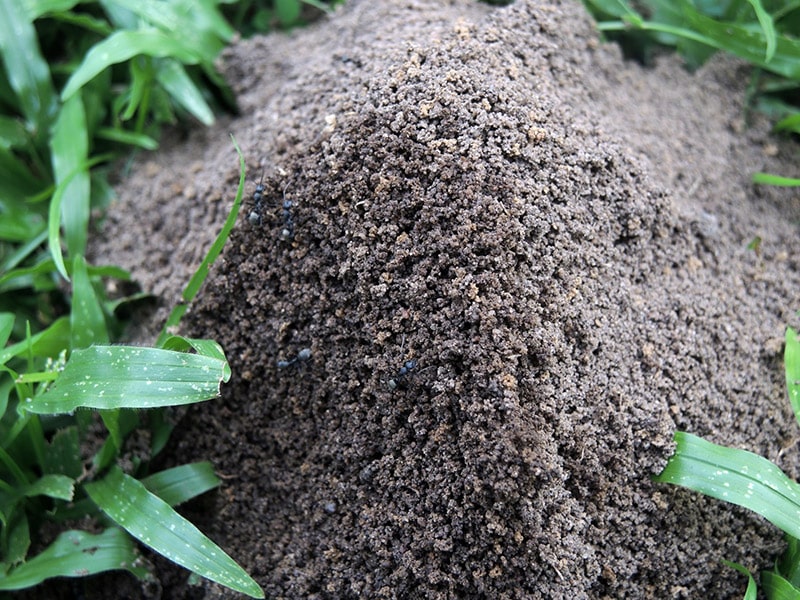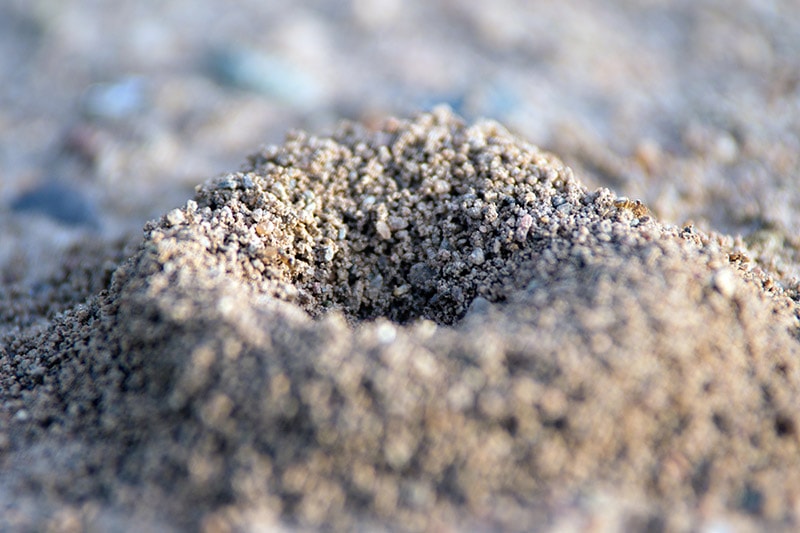Why Are There So Many Ant Hills in My Yard (3 Likely Reasons)
-

- Last updated:

Ants are generally considered the most successful animals in nature due to their ability to form complex social systems and adapt to changes in weather and population. Unfortunately, they are also a major cause of small holes and mounds in lawns. As they build their natural tunnel systems for their nests, they bring up organic matter, soil particles, and other debris to the surface. They pile up to form an anthill.
Not only are these anthills an eyesore in a beautifully manicured yard, but they can also be a fire hazard. They even prevent the proper growth of grass in some regions of your yard. So, why are ants attracted to yards?
In this article, we will highlight the different reasons why there may be anthills in your yard and whether they are harmful or beneficial. We will also discuss some methods of getting rid of anthills to have an even lawn in your compound. Read on to learn more.
The 3 Reasons for Anthills Appearing in Your Yard
Ants may be attracted to your backyard for various reasons. It could be because of the availability of water, food, or shelter in your yard. However, the main one is to provide a conducive environment for the queen to hatch new offspring. They may also be attracted by the food and water sources in your yard.
Unfortunately, as they dig the tunnels to get sustenance, they could end up causing damage to your lawn and weakening its structure. As such, many people advocate getting rid of anthills immediately when you notice them.
The following factors can make your yard a desirable home for ant colonies.
1. Reliable Water Source
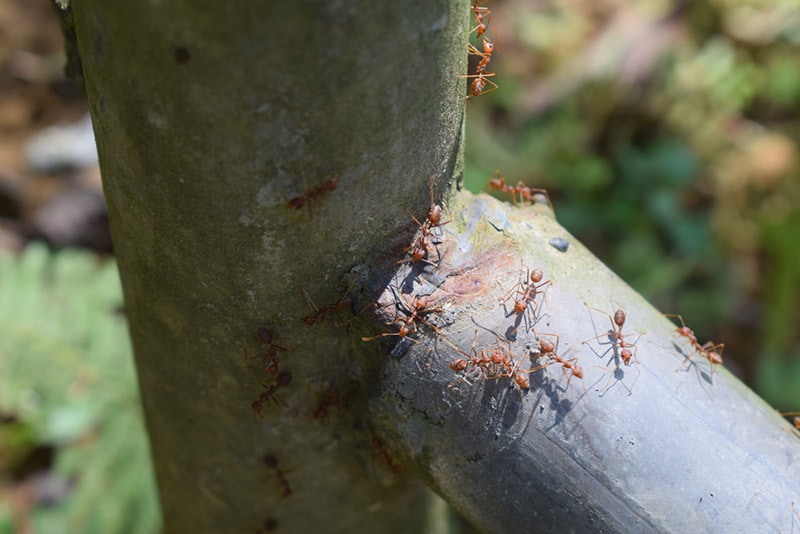
Ants are attracted to areas with a reliable water source to quench their thirst. Usually, ants will build their nests in your lawn if you have birdbaths, leaking underground pipes, or even stagnant water ponds.
Once the ants find the water source, they leave a scent for other ants to follow, and before you know it, you have a full-scale ant invasion. To get rid of them, ensure that there are no leaky pipes or standing water anywhere in your yard.
2. Your Yard Soil Has the Perfect Soil Conditions for Ants
Usually, ants prefer dry, sandy, and well-draining soils to make their anthills. These conditions are also required for grass to grow healthy and thrive. They also prefer plenty of sun exposure. Therefore, if your lawn is struggling and is riddled with empty patches, you may notice some anthills begin to form.
If your yard is healthy and lacks patches, chances are much lower that an anthill will appear. Furthermore, the looser the soil in your yard, the more likely that ants will be interested in making a home in your yard.
3. Presence of a Food Source in Your Yard
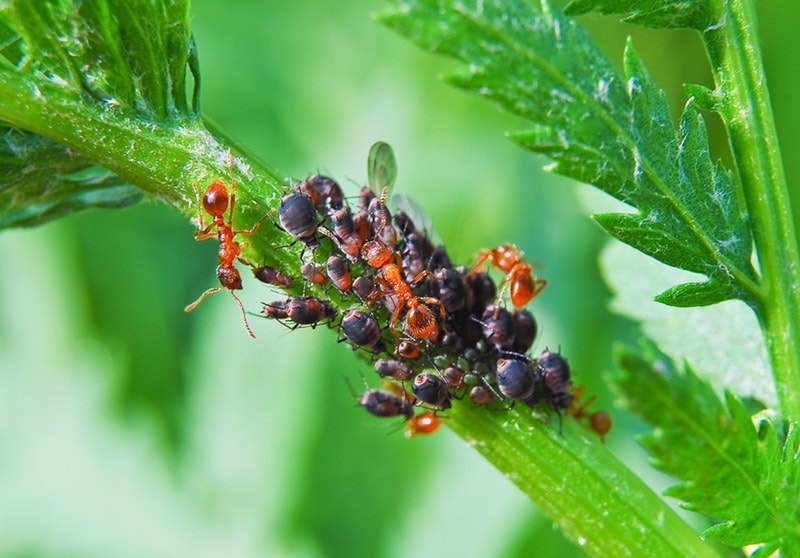
The biggest food source for ants is aphids. Aphids are essentially annoying bugs that appear in our vegetable gardens and flower beds. These small social insects cannot have enough of the honeydew produced by aphids.
Ants and aphids have a symbiotic relationship where they rely on each other for survival. While the ants help protect aphids from other predators, the aphids provide the ants with a constant supply of honeydew for the ant’s nourishment.
Granted, getting rid of the aphids may not completely rid of ants in your yard, but it can significantly reduce their numbers.
Additionally, most household garbage is stored in cans outside, usually in the yard. This tends to attract ants into your compound, especially if there is plenty of sweet and sugary food products in the bin. The other food sources that may attract ants into your yard include vegetables, fungi, fruits, grains, and other insect species.
Different ant species have different dietary preferences, but if you have any of the aforementioned potential food sources in your yard, the more the risk of an anthill presence in your yard.
Once a few ants scout out your yard and find plenty of nutrients, they leave behind a trail for the other ants to follow by producing a pheromone that other ants can detect and follow. Some other smells can attract ants into your yard, but usually, they tend to follow the musky scent produced by their counterparts.
Should You Get Rid of Anthills in Your Yard?
Now that you are aware of what attracts ants in your yard, should you get rid of anthills once they appear on your lawn? As mentioned earlier, anthills can be visually unappealing on a well-tended lawn. They also make mowing the lawn a herculean affair because one has to navigate uneven ground. They can even trip you if you are not looking where you step.
In some situations, ants are also harmful to plants because they tend to dry the soil surrounding the plant roots. They can even dry out parts of your lawn, leaving ugly patches in their wake. Furthermore, anthills can indirectly destroy your plants if the creatures are farming aphids. Since ants do not feed on the plants, the aphids will suck out all the sap from the plant, consequently destroying the plants in your yard.
Finally, ants may not be beneficial insects in your yard because of the possibility of being stung by one. Some species like fire ants can pose many inconveniences for pets and other household members. The chances of getting stung by ants are higher when the ant population increases.
Despite anthills causing uneven soil, tripping hazards, and possible ant bites, ants can be great for the ecosystem of your yard. For instance, ants improve the soil conditions as the tunnels built underground aerate the soil. Anthills can aerate the garden soil better than even earthworms can. Ants also eat fungi found in the soil.
Additionally, waste products from these social insects also help fertilize the soil. Their wastes contain amino acids and urea, which are vital ingredients in store-bought fertilizers. Ants also work as cleanup crews in the yard. They will gather and accumulate pest larvae and dead insects to save in their nests.
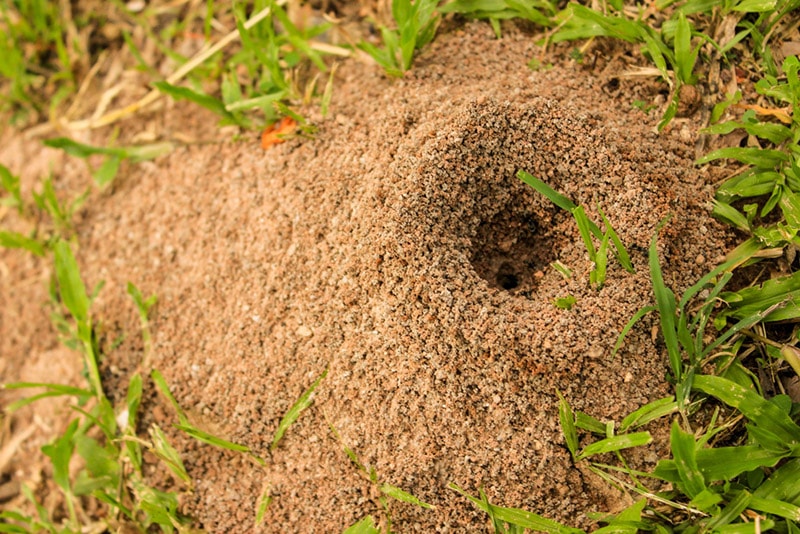
How to Get Rid of Anthills in Your Yard
As you may have gathered, having ants in your yard can be both beneficial and disadvantageous. However, you should consider getting rid of them to reclaim your property if the anthills affect your landscaping and the ability to make your yard visually appealing.
Fortunately, there are several ways to successfully remove anthills in your yard. Some of these methods may be natural and environmentally friendly, but others rely on chemical pesticides.
However, you should keep in mind that the best way to get rid of an anthill is to hire a professional pest control service. They will make sure the anthill is cleared, the ground leveled out, and give you advice on how to prevent ants from coming back into your yard.
Nevertheless, there are also some methods you can utilize to clear anthills out on your own. Here is how
Find the Anthill
In case you didn’t know, not all anthills display their presence over the grass line for you to see them. The majority of them are usually hidden underground. This poses a new set of problems and challenges. For starters, you may have to get a lot of bait to spread it around your property.
Second, ants may have built a nest outside your property line but still visit your yard as they look for food and water. This makes it even more difficult to get rid of them. Nevertheless, finding the anthill should be your priority and may require a lot of patience.
You will have to follow the ants to their base of operations. Since ants are guided by pheromones, they use the same path back to their hill. So, consider planting some bait in their trail and watch where they go.
Use Hot Water
Most gardening experts also recommend pouring hot boiling water into an anthill to get rid of them. This method is suitable when dealing with ants directly underneath the anthill. However, chances are slim that the water will spread to every nook and crevice in their dense tunneling system unless you use a significant amount of water. This method can also possibly kill any plants in the vicinity hit by the scalding water.
According to a study by the University of Florida, while boiling water may be highly effective, it does not entirely get rid of ant colonies unless you employ multiple treatments. Therefore, it is best to use at least 3 gallons of water when you utilize this method. Some people even suggest pouring gasoline into an anthill, but do not do this! You will not only get rid of the ants but also destroy the surrounding plant life that you may want to keep after the anthill is gone.
Use Spice
Whenever we taste spicy products, there is always a clear reaction in our bodies. Our eyes tear up, and our tongues burn up. Ants experience the same reaction. These social creatures cannot stand the smell of spicy cinnamon, black pepper, bay leaves, cloves, and cayenne pepper.
This method may not completely clear up the ants but pouring a spice mixture in an anthill will make it inhospitable to the colonies, prompting them to move.
To use this method, simply sprinkle a mixture of different spices and pour them down an anthill. You can also create a solution with water and pour it down at the entrance and exit of the anthill. By creating an inhospitable environment, you start the process of getting rid of them and their underground dwellings.

Boric Acid and Sugar
This is another easy yet effective way of getting rid of ants from an anthill in your yard. However, you should first consider contacting a professional because boric acid is toxic to humans.
Nevertheless, mixing a cup of sugar with a tablespoon of boric acid and water should get rid of ants from an anthill. Applying the paste around the anthill entrance will attract the ants, but instead of sugary food, they will carry back poison to their colonies.
Using Vinegar
Vinegar has for a long time been used to get rid of harmful insects. However, if you want to use it in your yard to get rid of ants in an anthill, keep in mind that you will be putting any surrounding plants at risk. This is because vinegar is a weed killer.
To use this method, mix 50% vinegar with 50% water. Pour the mixture at the anthill entrance and exits, and it will get rid of anthills from your lawn. Yet, just like using boiling water, this method will not be able to get rid of all the ants but will create a huge dent in their overall population. This will deter the ants from coming back into your yard.

Fossilization
If the deterrent methods do not seem to work, you can opt to use diatomaceous earth. It is essentially a non-toxic ant killer that is very effective at getting rid of ants in an anthill. This product is made from fossilized phytoplankton and algae. When ants come into contact with this product, they are immediately destroyed.
Before using diatomaceous earth, you should first identify the ant trails and sprinkle them along the path. Any ants above the anthill surface will be taken out as soon as you sprinkle directly on top of them. You can also create a perimeter around the anthill with the product.
Just sprinkle liberally around the hill, mix the earth with dirt, expose the inner part of the hill, and sprinkle more diatomaceous earth into it. After about 24 to 48 hours, the ants should have stopped spilling out of the mound. You can then proceed to level the anthill.
Leveling Out the Anthills
After utilizing any of the above mentioned methods, you should have taken out a huge chunk of the ant population from the anthill in your yard. This should be enough to displace them permanently. Now you can proceed to clear and level out the anthill to remove the ugly mounds from your lawn.
If the anthill was in a part of your yard where lawn grass was growing, you can use a rake to smoothen the ground. However, be careful not to smother the surrounding grass. Also, remove excess soil to avoid covering the grass too much.
If you use chemical-based plant killers to get rid of the ants underground, remove the affected soil and replace it with untouched garden soil. Once the soil is loosely mixed up and the area is flat, you can sprinkle some grass seeds in the area as you restart the process of re-growing your lawn grass.
Find a pest-control specialist in your area, and get free, no-commitment estimates for your project.Consult a PEST-CONTROL expert

Conclusion
Ants have always been considered beneficial insects to the soil. They not only create extensive burrow systems underground that aerate the soil, but they also improve soil fertility as they break down organic matter to create their nests.
Unfortunately, when ants are left to their own devices, they can invade your home and damage your lawn with their uneven and eyesore anthills. Therefore, you need to control their population, especially when the anthills interfere with landscaping and the beauty of your lawn.
There may be several methods out there for getting rid of anthills, but ensure the one that you opt for does not damage or kill the plants in your yard. Natural methods are ideal, but if they do not work, you can then opt to use non-toxic methods such as the fossilization process to get rid of them.
Featured Image Credit: Mountains Hunter, Shutterstock
Contents

